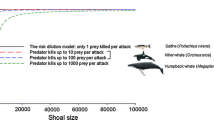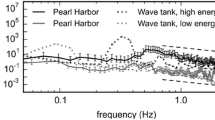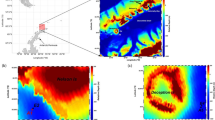Abstract
Dense copepod aggregations form in Massachusetts Bay and provide an important resource for right whales. We re-examine the processes which might account for the high concentrations, investigating both horizontally convergent flow, which can increase the density of depth-keeping organisms, and social behavior. We argue that the two act in concert: social behavior creates small dense patches (on the scale of a few sensing radii); physical stirring brings them together so that they merge into aggregations with larger scales; it also moves them into areas of physical convergence which retain the increasingly large patch. But the turbulence can also break this apart, suggesting that the overall high density in the convergence zone will not be uniform but will instead be composed of multiple transient patches (which are still much larger than the sensing scale).













Similar content being viewed by others
Notes
Social behavior models, especially when observations in the natural habitat are minimal, are necessarily speculative. Copepods clearly exhibit directed swimming in response to pheromones (c.f. [30] and other articles in that volume) as well as hydromechanical and perhaps visual cues. Food distribution might also be a factor.
When the swimming is time-dependent but the time for forming a layer remains short, we would just end up integrating \(F(z,t)\mathbf{u}\), introducing additional time-dependence in \(\tilde{u}\).
References
Batchelor, G.K.: Steady laminar flow with closed streamlines at large Reynolds numbers. J. Fluid Mech. 1, 177–190 (1956)
Baumgartner, M.F., Cole, T.V., Clapham, P.J., Mate, B.R.: North Atlantic right whale habitat in the lower Bay of Fundy and on the SW Scotian Shelf during 1999–2001. Mar. Ecol. Prog. Ser. 264, 137–154 (2003)
Baumgartner, M.F., Mate, B.R.: Summertime foraging ecology of North Atlantic right whales. Mar. Ecol. Prog. Ser. 264, 123–135 (2003)
Beardsley, R., Epstein, A., Chen, C., Wishner, K., Macaulay, M., Kenney, R.: Spatial variability in zooplankton abundance near feeding right whales in the Great South Channel. Deep Sea Res. Part II 43, 1601–1625 (1996). doi:10.1016/S0967-0645(96)00050-1
Birch, D.A., Young, W.R., Franks, P.J.S.: Thin layers of plankton: formation by shear and death by diffusion. Deep-Sea Res. I 55, 277–295 (2008)
Birch, D.A., Young, W.R., Franks, P.J.S.: Plankton layer profiles as determined by shearing, sinking, and swimming. Limnol. Oceanogr. 54, 397–399 (2009)
Chen, C., Liu, H., Beardsley, R.: An unstructured grid, finite-volume, three-dimensional, primitive equations ocean model: application to coastal ocean and estuaries. J. Atmos. Ocean. Techn. 20, 159–186 (2003)
Dewar, W.K., Flierl, G.R.: Particle trajectories and simple models of tracer transport in coherent vortices. Dyn. Atmos. Oceans 9, 215–252 (1985)
Epstein, A.W.: Physical processes and zooplankton distribution in the great south channel: Observational and numerical studies. Ph.D. Thesis, MIT/WHOI Joint Program in Physical Oceanography (1995)
Epstein, A.W., Beardsley, R.C.: Flow-induced aggregation of plankton at a front: a 2-d Eulerian model study. Deep Sea Res. Part II 48, 395–418 (2001)
Flierl, G., Grünbaum, D., Levin, S., Olson, D.: From individuals to aggregations: the interplay between behavior and physics. J. Theoret. Bio. 196, 397–454 (1999)
Fong, D., Geyer, W., Signell, R.: The wind-forced response on a buoyant coastal current: observations of the western Gulf of Maine plume. J. Mar. Sys. 12, 69–81 (1997)
Franks, P.J.S.: Sink or swim: accumulation of biomass at fronts. Mar. Ecol. Prog. Ser. 82, 1–12 (1992)
Franks, P.J.S.: Spatial patterns in dense algal blooms. Limnol. Oceanogr. 42, 1297–1305 (1997)
Genin, A., Jaffe, J.S., Reef, R., Ricther, C., Franks, P.J.S.: Swimming against the flow: a mechanism of zooplankton aggregation. Science 308(860), 4 (2005)
Helfrich, K., Pineda, J.: Accumulation of particles in propagating fronts. Limnol. Oceanogr. 48, 1509–1520 (2003)
Lamb, H.: Hydrodynamics, 6th edn. Camb. Univ. Press, Camb., Eng. p. 738. (Dover edition, Dover publ., NY). See Ch. 1, Art. 14 (1932)
Nøttestad, L., Simlä, T.: Killer whales attacking schooling fish: why force a herring from deep water to the surface? Mar. Mamm. Sci. 17(2), 343–352 (2001)
Olson, D.B., Backus, R.H.: The concentrating of organisms at fronts: a cold-water fish and a warm-core gulf stream ring. J. Mar. Res. 43(1), 113–137 (1985)
Ostrand, W.D., Howlin, S., Gotthardt, T.A.: Fish school selection by marbled murrelets in Prince William Sound, Alaska: responses to changes in availability. Mar. Ornithol. 32, 69–76 (2004)
Pedlosky, J.: Geophysical Fluid Dynamics, 2nd edn, p. 710. Springer, Berlin (1987)
Pitcher, K.W., Calkins, D.G.: Reproductive biology of steller sea lions in the Gulf of Alaska. J. Mammal. 62, 599–605 (1981)
Rhines, P.B., Young, W.R.: How rapidly is a passive scalar mixed within closed streamlines? J. Fluid Mech. 133, 133–145 (1983)
Rothschild, B.J., Osborn, T.R.: Small-scale turbulence and plankton contact rates. J. Plankton Res. 10, 465–474 (1988)
Schoenherr, J.R.: Blue whales feeding on high concentrations of euphausiids around Monterey submarine canyon. Can. J. Zool. 69(3), 583–594 (1991)
Sims, D.W., Quayle, V.A.: Selective foraging behaviour of basking sharks on zooplankton in a small-scale front. Nature 393(6684), 460–464 (1998)
Werner, S., Beardsley, R., Lentz, S., Hebert, D., Oakey, N.: Observations and modeling of the tidal bottom boundary layer on the southern flank of Georges Bank. J. Geophys. Res. 108(C11), 8005 (2003)
Wishner, K.F., Schoenherr, J.R., Beardsley, R., Chen, C.: Abundance, distribution and population structure of the copepod Calanus finmarchicus in a springtime right whale feeding area in the southwestern Gulf of Maine. Cont. Shelf Res. 15, 475–507 (1995)
Woods, N.W.: Physical controls on copepod aggregations in the Gulf of Maine. Ph.D. thesis, MIT-WHOI Joint Program, p. 213 (2013)
Yen, J., Weissburg, M.J., Doall, M.H.: The fluid physics of signal perception by mate-tracking copepods. Phil. Trans. Roy. Soc. B 353, 787–804 (1998)
Author information
Authors and Affiliations
Corresponding author
Appendices
Appendix 1: Vertical Swimming
For organisms swimming vertically at a speed \(w_s(z,t)\) with random variations producing a “diffusion” \(K_s(z,t)\) (presuming both have significant variation only in \(z\)), the density satisfies
(with \(\mathbf{u}\) and \(\nabla \) being horizontal and \(w\), \(K_v\) being the physical vertical motion and mixing, respectively). We assume that the vertical swimming is strong and convergent at some preferred depth (including the surface or bottom). The lowest order dynamics (neglecting time-variation of the swimming) is
Then \(b\) will take the form \(\tilde{b}(\mathbf{x},t)F(z)\) with
(like Eq. 2 but in the vertical). If the swimming propels the organisms up or down towards a particular depth and is rapid, the vertical scale of \(F\), \(K_v/w_s\), will be small, and \(F\) will be sharply peaked around the preferred depth (by analogy to Fig. 1). Using the \(\tilde{b} F\) solution to iterate on the original equation gives
Since we are interested in the net biomass, we shall normalize \(F\) by taking \(\int dz\,F=1\) and integrate the equation above. There is no flux through the boundaries and \(w\) vanishes as well. We arrive at the equation for \({\partial \over \partial t}\tilde{b}\) in the text with divergent horizontal flows \(\tilde{\mathbf{u}}\) and associated stretching.Footnote 2
Appendix 2: Circular and Non-Symmetric Geometries
When the streamfunction, potential, and boundary conditions are all independent of \(\theta \), we again have
We can solve the same problems, just replacing \(x\) by \(r\) and limiting the domain to be \(r\ge 0\). We argue in Sect. 4.2 that \(\phi \sim \psi \) so that an isolated eddy can be expected to have localized radial velocities as well. In this case, the far field can have a finite background value, and the steady state solution has a central amplitude order \(\exp (P)\) larger. But, as Appendix 3 shows, this buildup happens in two stages: first, the patch gets denser by drawing in the organisms out to where the velocity peaks and depleting the annulus where convergence occurs. Then the peak value changes more slowly, on a time scale \(L^2/K\), because of diffusion into the depleted area and then into the center until the convergence and diffusion balance (Table 2).
If the symmetry is broken, the flux \(F_0\) will no longer be zero. The steady solution now has
so that
where \(b_s\) is the homogeneous solution, with amplitude chosen to match the condition at \(x_0\). The flux \(F_0\) is chosen to match the right boundary condition.
The solution (Eqs. 2a, 2b) will also apply to other steady flow cases. When contours of \(\phi \), \(K\), and \(\psi \) are parallel, the form
gives a flux
The divergence of the flux is
which vanishes under the stated assumptions.
In the circular geometry, the rotational flux will have a contribution if the boundary or initial conditions vary with angle. For example, if \(b\) is not constant on some closed \(\phi \) contour, the solution above cannot hold. The strong flow case seems most relevant: when the rotational flow is large compared to the convergent flow, the density will homogenize along streamlines by shear dispersion and then slowly diffuse and converge across them. This argument is based on the Prandtl-Batchelor theorem [1]. The lowest order solution to
is just
which implies \(b=b(\psi ,t)\). Integrating the equation over the area enclosed by two streamlines gives
If we use the approximation that \(b=b(\psi ,t)\) and take \(d\psi \) to be small, this becomes
(c.f., [23]). This 1D advection-diffusion equation has much the same character as the cases discussed previously; the exception would be if there is a stagnation point in \(\mathbf{u}_\psi \) which corresponds to a singularity in the time for transiting the contour – which is the coefficient of \({\partial \over \partial t}b\). The assumption of rapid movement along streamlines compared to the diffusion or cross streamline flow clearly breaks down there, but, as [8] argued, it does not make a significant difference. We still expect to find \(b\) will tend towards
but with the divergent flow and effective diffusivity suitably weighted by the along-streamline velocity
Figure 14 shows this process with a Gaussian \(\psi \), starting from a checkerboard pattern, which then becomes spirals and converges into the middle. The maximum amplitude at the last time shown is still only 5.6 times the boundary value; it will climb to order \(e^{10}\).
Appendix 3: Time-Dependent Problems
Even in the case with symmetric boundary conditions, the localized flow problem has several different time scales (Fig. 15). Initially, the patch gets denser by drawing from the surrounding annulus where the velocity peaks and it compresses into the center. This occurs with a time scale of order \(L^2/\phi _0\); then the peak value changes more slowly because of diffusion in or out of the boundary on a time scale \(L^2/K\). The distribution finally stabilizes at
as shown in Fig. 15.
a The initial condition and the density at \(t=L/U\) as functions of \(r/L\), showing the depletion of the annular region. (\(P=10\) for this plot; \(b(0,70)=97.3\). b The growth of the maximum for various boundary values. Time is non-dimensionalized by \(L/U\) and \(P=3\). The initial value of \(b\) is one. c The evolution of \(b\) versus \(tU/L\) and \(r/L\). Contours are at \(b=0.75,0.8,\ldots ,0.95,1,2,\ldots ,18\)
The solutions with non-zero inflow in the far field can only settle to a steady solution if the population initially extend over a finite area: if \(b\) is non-zero as \(x\) or \(r\) \(\rightarrow \pm \infty \), the flows will continue to import organisms into the system. In the pure strain case, beginning with uniform \(b\) is not very physical: it leads to simple exponential growth with time everywhere \(b=b(0)\exp (Ut/L)\). The localized front case is more interesting because the far-field population remains constant. For the special case when the Péclet number is equal to 2, \(U_0=0\), and the population is uniform at \(t=0\), there is a simple analytic solution to the time-dependent problem:
The second term is just the steady-state solution but with amplitude growing linearly in time as new organisms are brought in from further and further away. To reach amplitudes 100 times the background \(b(0)\), the flow has to be sustained and far-reaching enought to bring organisms from a distance 100 times the front width. Indeed, if we ignore diffusion entirely, the solution is just
At the origin, this grows exponentially, but a short distance away, the concentration asymptotes to \(|\coth (x/L)|\) which is only 1.3 for \(x=L\) or 4 for \(x={1\over 4}L\). from the expression for the ratio
it is clear that the time to approach large amplitudes (meaning small values of \(x\)) behaves like \(-L/U\ln (\sinh [x/L]) \sim (L/U)\ln R\) and increases significantly. In the presence of diffusion, we see growth at \(x\) (away from zero) by advection like that above until \(ub\) is nearly constant and then a slower phase where diffusion is spreading the central peak.
Frontal models of accumulation often have localized convergence but velocities extending far from the front (e.g., [10] have a \(-\tanh (x)\) flow); these models argue that the accumulation will be modest if the front has localized velocities or lasts for times which are not tremendously long compared to \(L/|\nabla \phi |\).
Appendix 4: Advective Losses
To understand advective losses, consider the movement relative to the plume: the organisms approach the front, but are left in the surface as the denser water goes under the plume (really the plume riding over relatively still water). But they can diffuse through the front to be picked up by the plume-relative flow inside or be swept along the front. In a 1D model, we can think of this as a localized convergence but with different velocities on each side. For \(u=U_0-U\tanh (x/L)\) with \(U_0>U\), the concentration transitions smoothly and monotonically from its upstream value \(b(-\infty )\) to the downstream value \(b(\infty )=b(-\infty )(U_0+U)/(U_0-U)\) which gives the same flux \(ub-K{\partial \over \partial x}b = u(-\infty )b(-\infty )\). The amplification is independent of \(P\). If we use a slightly more complex velocity which drops to zero at the front, but picks up on the other side
the concentration far downstream is still enhanced by \(u(-\infty )/u(\infty ) = 1/(1-2a)\), but the temporary blockage caused by slow diffusion across the front gives a local peak; however the amplitude increases only roughly linearly in \(P\) rather than exponentially (Fig. 16).
In two dimensions, advective losses can be even more significant. Consider a strain field like that which may occur near the intersection of the nose with the wall. Relative to the moving plume, the velocity would look like
where either coefficient could be negative or zero. The potential is
and we will only reach an appropriate steady state [\(\exp (-\phi /K)\)] if both \(A\) and \(B\) are positive. We shall look for Gaussian solutions
This leads to three equations
The equations for \(\alpha \) and \(\beta \) are the logistic equations; if \(B\) is positive, \(\beta \) will initially grow exponentially and then asymptote to \(A/K\). But if \(B<0\), then \(\beta \) decays to zero and the width in that direction becomes infinite. Combining the three equations shows that \(b_0/\sqrt{\alpha \beta }\) is constant. Thus, if both scales limit to finite values, \(b_0\) will also. If either \(A\) or \(B\) is negative, the patch cannot resist the divergence in that direction and the amplitude will decay to zero. However, when that coefficient is small, we can have substantial amplification and then a slow decay (Fig. 17).
Even if the “upstream” population is maintained in a band near the coast (i.e., the front is moving into a region with some background concentration), the peak concentration levels off in much the same way as in the 1D problem (Fig. 18). This example shows that advective losses can be an important limiter on the density enhancement associated with convergence.
Rights and permissions
About this article
Cite this article
Flierl, G.R., Woods, N.W. Copepod Aggregations: Influences of Physics and Collective Behavior. J Stat Phys 158, 665–698 (2015). https://doi.org/10.1007/s10955-014-1162-0
Received:
Accepted:
Published:
Issue Date:
DOI: https://doi.org/10.1007/s10955-014-1162-0









